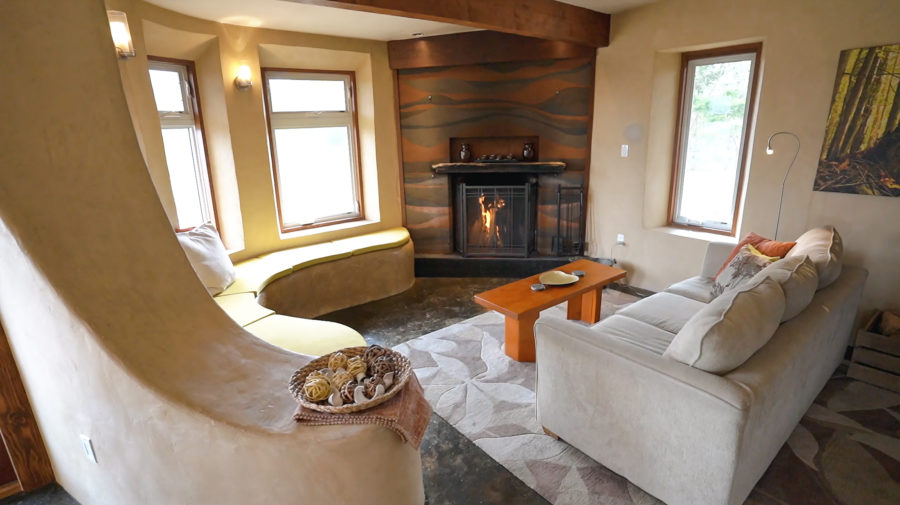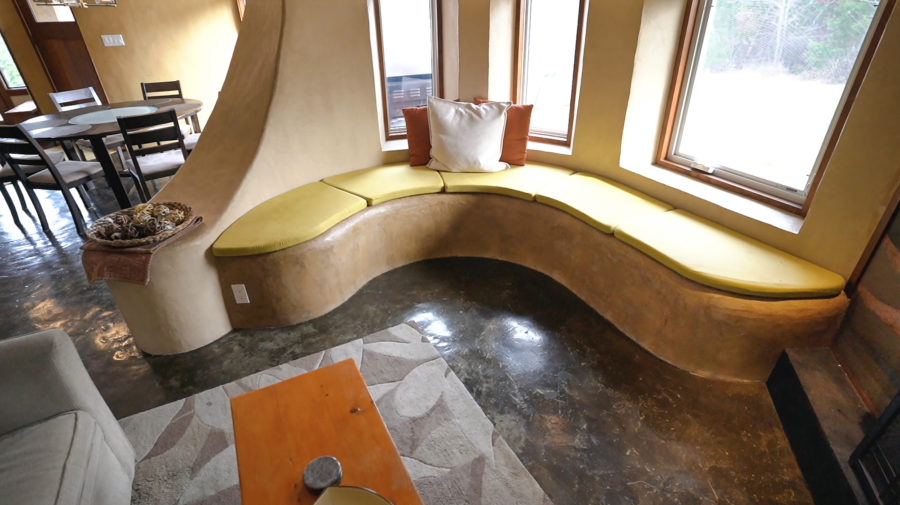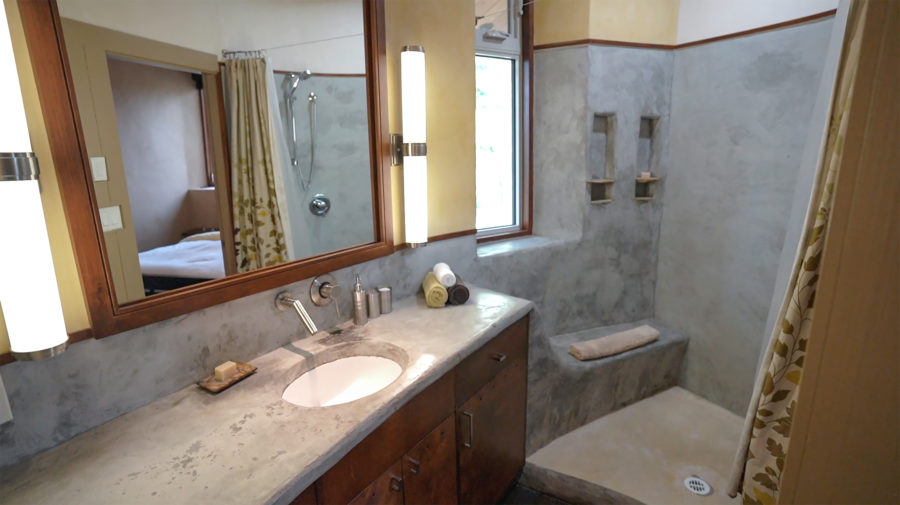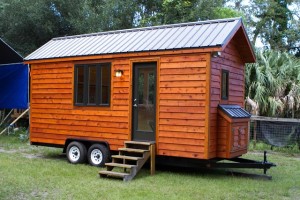This post contains affiliate links.
This monolithic cob house is completely off-grid with a 1-kilowatt solar power system and a backup generator for electricity, a Rumford fireplace and propane radiant in-floor heating, and a constructed wetland for natural wastewater treatment.
The modern interior living space is approximately 1,000 square feet in size with an open-concept kitchen, dining, and living room, as well as 2 bedrooms, a mechanical room, and a bathroom.
Monolithic Cob House With Solar-Power

Image © Exploring Alternatives
Most cob homes are built with a timber frame structure, and the cob – a mixture of sand, clay, and straw – is used to fill in the walls. This home is quite different because it’s a structural cob house, so the 2-foot thick walls are load-bearing, and they support the weight of the roof.

Image © Exploring Alternatives
Since it was built in a seismic zone, the home had to be engineered and built to withstand earthquakes. It was built with curved walls to strengthen the structure, as well as with airplane cables that connect the wall plate to the foundation in order to resist lateral forces.

Image © Exploring Alternatives
The living room has a wall that swoops in from outside and really showcases the thickness of the cob walls. There’s a built-in cob bench, a couch, and a Rumford fireplace inset into a beautiful rammed earth wall.

Image © Exploring Alternatives
The kitchen is simple and functional with loads of storage space inside the extended island, a massive cast iron sink, an energy-efficient fridge, and a propane stove with a battery-powered ignitor to save on power (no additional electricity needed!).

Image © Exploring Alternatives
There are two bedrooms in the house, one on the East side, and one on the West side. Both rooms have South-facing windows in the clearstory to let in light and warmth from the sun. The rooms each fit a Queen-size bed and have large closets with curtains. The owners feel that the cloth curtains provide a nice texture contrast to the solid cob walls.

Image © Exploring Alternatives
The bathroom has a beautiful waterfall counter that cascades into the shower to create a bench. There is a pocket door between the toilet and shower so that both can be in use at the same time.
Tonya and Leon built started to build this home in 2010 with the goal of creating a retreat where people could experience and learn about natural building techniques. It has been shared with visitors for nearly 10 years and will soon become a full-time home for its new owners.
Check out the video below for a full tour!
VIDEO: This Epic Cob House is Off-Grid and Earthquake Resistant!
Additional Resources
You can share this using the e-mail and social media re-share buttons below. Thanks!
If you enjoyed this you’ll LOVE our Free Daily Tiny House Newsletter with even more! Thank you!
More Like This: Cabins | Cob | Cottages | Off-Grid | Small Houses
See The Latest: Go Back Home to See Our Latest Tiny Houses
This post contains affiliate links.






What s wonderful home, there should be lots more like this built! Being off grid and having the natural wastewater treatment is amazing. Brilliantly done thanks for sharing.
WOW! Such a beautiful home! And all natural at that! Gorgeous! Wish I had one!
So many great things about this build. And one thing I noticed and really appreciated is the commercial didn’t interrupt the video which makes me more than willing to check them out and possibly use them. This one is one I will not only share but will keep on file for future use. Thank you 😊
Just three words… I Love This
Both rooms have South-facing windows in the clearstory to let in light and warmth from the sun.
I think you meant clerestory rather than clearstory. Yup, we all make ’em at some stage…
Actually, both apply… A clearstory is part of an interior wall rising above the adjacent roof with windows admitting light clerestory window…
Well I’ve learnt something I didn’t know before.
Where is this house? I don’t think the written words or the video said – if it did, I missed it!
It looks like Northern California.
Google is your friend… Lake Cowichan, British Columbia… written word is in the video.
I love this one! Seems to have all I would want. 😉
Interesting…but the problem with these types of structures is that they’re not easy to modify if you change your mind about something later. Additionally (I haven’t watched the video), how easy is it to fix plumbing or electrical wiring issues? Seems like the plumbing is built into the walls, which would require some destruction to get at the plumbing or wiring.
2-foot thick walls…wow, I bet the insulation quality is incredible.
What makes you think they’re hard to modify?
It does require a lot of labor but Cob is a free form structure that can be molded into just about any shape, making changes just requires labor just like the original construction. While you would be demoing, etc. too with a traditional stick framed house to remodel it and drywall would have similar issues to get to pipes, etc. So not that much difference aside from the amount of labor and dealing with such thick walls, etc.
While it’s access panels and service cavities that make servicing easier and you can add that to a cob house too to help alleviate that concern.
Anyway, it’s also about thermal mass with earthen structures and not just insulation value… So works a little differently but yes, usually super effective…
What would it cost to build a cob house for one person and 2 dogs? Do you only build where you live or do people commission your work to build in other parts of the world? Is a build in Cost Rica out of the question because of the rain? Just love your Cob House video.
Cheryl
Well I’ve learnt something I didn’t know before.